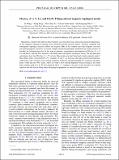| dc.contributor.author | Wang, Di | |
| dc.contributor.author | Tang, Feng | |
| dc.contributor.author | Po, Hoi Chun | |
| dc.contributor.author | Vishwanath, Ashvin | |
| dc.contributor.author | Wan, Xiangang | |
| dc.date.accessioned | 2020-08-13T17:13:56Z | |
| dc.date.available | 2020-08-13T17:13:56Z | |
| dc.date.issued | 2020-03 | |
| dc.date.submitted | 2019-10 | |
| dc.identifier.issn | 1550-235X | |
| dc.identifier.issn | 2469-9969 | |
| dc.identifier.uri | https://hdl.handle.net/1721.1/126564 | |
| dc.description.abstract | Magnetism, coupled with nontrivial band topology, can bring about many interesting and exotic phenomena, so that magnetic topological materials have attracted persistent research interest. However, compared with nonmagnetic topological materials (TMs), the magnetic TMs are less studied, since their magnetic structures and topological phase transitions are usually complex and the first-principles predictions are usually sensitive on the effect of Coulomb interaction. In this work we present a comprehensive investigation of XFe[subscript 4]Ge[subscript 2](X=Y,Lu) and Mn[subscript 3]Pt, and find these materials to be filling-enforced magnetic topological metals. Our first-principles calculations show that XFe[subscript 4]Ge[subscript 2](X=Y,Lu) host Dirac points near the Fermi level at high symmetry point S. These Dirac points are protected by PT symmetry (P and T are inversion and time-reversal transformations, respectively) and a twofold screw rotation symmetry. Moreover, through breaking PT symmetry, the Dirac points would split into Weyl nodes. Mn[subscript 3]Pt is found to host fourfold degenerate band crossings in the whole high symmetry path of A–Z. We also utilize the GGA+U scheme to take into account the effect of Coulomb repulsion and find that the filling-enforced topological properties are naturally insensitive on U. | en_US |
| dc.publisher | American Physical Society | en_US |
| dc.relation.isversionof | 10.1103/PhysRevB.101.115122 | en_US |
| dc.rights | Article is made available in accordance with the publisher's policy and may be subject to US copyright law. Please refer to the publisher's site for terms of use. | en_US |
| dc.source | American Physical Society | en_US |
| dc.title | XFe4Ge2(X=Y,Lu) and Mn3Pt: filling-enforced magnetic topological metals | en_US |
| dc.title.alternative | XFe[subscript 4]Ge[subscript 2](X=Y,Lu) and Mn[subscript 3]Pt: Filling-enforced magnetic topological metals | en_US |
| dc.type | Article | en_US |
| dc.identifier.citation | Wang, Di et al. "XFe4Ge2(X=Y,Lu) and Mn3Pt: filling-enforced magnetic topological metals." Physical Review B 101 (March 2020): 115122 doi 10.1103/PhysRevB.101.115122 ©2020 Author(s) | en_US |
| dc.contributor.department | Massachusetts Institute of Technology. Department of Physics | en_US |
| dc.relation.journal | Physical Review B | en_US |
| dc.eprint.version | Final published version | en_US |
| dc.type.uri | http://purl.org/eprint/type/JournalArticle | en_US |
| eprint.status | http://purl.org/eprint/status/PeerReviewed | en_US |
| dc.date.updated | 2020-03-13T14:34:37Z | |
| dc.language.rfc3066 | en | |
| dc.rights.holder | American Physical Society | |
| dspace.date.submission | 2020-03-13T14:34:37Z | |
| mit.journal.volume | 101 | en_US |
| mit.license | PUBLISHER_POLICY | |
| mit.metadata.status | Complete | |
